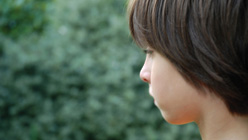Sanford Newmark, head of the Pediatric Integrative Neurodevelopmental Program at UCSF, says that doctors are also at a loss to explain the increased rate of autism.
“I don’t think we know,” he said. “It’s certainly partly better diagnosis, but it’s possible that there are more kids out there who have autism.”
One factor that may have led to the rise in autism diagnosis is that doctors are now more attuned to the early signs of autism. Newmark says that kids who are developing normally will begin to babble by eight months of age, but that kids with autism don’t. Another difference is that most kids will try to get their parents’ attention by pointing to something, but that kids with autism don’t have the same impulse to be social.
That is something that Shannon Des Roches Rosa, an author and blogger, said that she saw in her autistic son when he was an infant. She described him at 18 months as having what she called a lack of “joint attention” – he was not interested in looking at the same things all the grown-ups were. “He was not responding to his name, and he was not responding to a lot of social cues,” she said.
Newmark added that when the parents smile or laugh, a young child should smile in response. “A warning sign is if the child just doesn’t pay any attention to that,” he said.
If parents suspect their child is showing early signs of autism, Newmark says they should seek support. “That is, to me, the most important part of what could come out of this [CDC study] -- is early screening.”
Both he and Des Roches Rosa think that parents should find a pediatrician they are comfortable with, one who they trust. If parents and their doctor find signs that a child may have autism, the next step is to get a formal evaluation at a state-run center. From there, children with autism or developmental delay can get access to speech, occupational, physical and most important, behavioral therapy.
Newmark says that researchers are continuing to look for treatment options beyond therapy that may help kids with autism, but that's not easy.
“We certainly don’t know the cause of autism, and that does make it more difficult to find a really great treatment,” he said.
Both he and Des Roches Rosa caution that parents should not try new treatments just because they feel they must do something. They recommend that parents should critically evaluate any treatment options they come across and be sure that they are safe and worth the risk.
